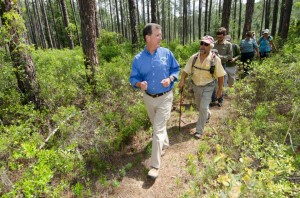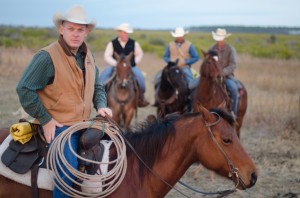
By BRUCE RITCHIE
Floridaenvironments.com
Biologist Joe Guthrie sounds like he’s being too hard on himself for not taking more notes or recording data on his recent 1,000-mile trek with the Florida Wildlife Corridor Expedition.
Guthrie and photographer Carlton Ward Jr., conservationist Mallory Lykes Dimmett and documentary filmmaker Elam Stoltzfus finished their journey April 22 in the Okefenokee Swamp National Wildlife Refuge.
They began Jan. 17 from Flamingo on Florida Bay and walked, paddled, bicycled and rode horses through the middle and eastern side of the Florida peninsula. They sought to raise awareness of the need for connecting public lands and conserving habitat through the corridor.
Ward shot photos of wild turkeys, sandhill cranes, wood storks, indigo snakes and the ranchers and public lands managers who work the lands.
In a blog on the expedition web site, Guthrie describes their interactions with people and issues involving the landscape connections.
But Guthrie said he’s frustrated at himself for not having the foresight — or the time, really — to record and keep data along the trip.
“I kept some notes. Often that was impossible to do — for days and weeks at a time,” he said.
“We did host a lot of people and had various groups joining us along the way. I’m the kind of person if someone is around I tend to want to be sociable, hang out and enjoy people’s company. It comes at a cost of isolating yourself (while) taking your thoughts and putting them down on paper.”
And it’s obvious that hanging out with people is important in creating awareness.

The expedition was joined by Attorney General Pam Bondi, Agriculture Commissioner Adam Putnam, Florida Department of Environmental Protection Secretary Herschel T. Vinyard Jr. and Nick Wiley, executive director of the Florida Fish and Wildlife Conservation Commission.
And there were the scientists and researchers such as explorer J. Michael Fay of National Geographic, state bear biologist Brian Sheick, Hilary Swain of Archbold Biological Station, snake researcher Zach Forsburg of the Orriane Society and Jennifer Smith of Virginia Tech, who is researching crested caracaras.
Creating awareness on such a trip is an important, Harvard biologist Edward O. Wilson said last week in Tallahassee when he was asked to comment on the expedition. Wilson gave a commencement address at Florida State University.

“I wasn’t familiar with the details (of the expedition) but it has value for sure,” Wilson said. “Even if it just for public awareness that leads to support for serious kinds of research.”
Tom Hoctor, director of the University of Florida Center for Landscape Conservation Planning, said the trip will have a scientific benefit with the photographs, documentary film and Guthrie’s observations on where bottlenecks and challenges exist for creating a landscape corridor through the region.
“Folks who do science-based planning work like I do have good access to geographic information data,” said Hoctor, who Guthrie credits for creating the Florida Wildlife Corridor concept.
“It (data) is still not the same as paddling it, walking it, biking it like they did,” Hoctor said. “We haven’t had that experience.”
And Hoctor said Guthrie and the crew members haven’t had time to gather their thoughts and prepare the story of their expedition.
Guthrie said he has in his head now knowledge of the conservation connections that can be made to preserve black bear habitat. He said when he has some time to relax, he will write a paper about the expedition and possibly an article for the popular press.
Every day along the trip, he said, was full of surprises — such as the scale of the aptly named Big Scrub in the Ocala National Forest, the frequency of nest cavities for the endangered red-cockaded woodpecker, the vast remaining stretches of longleaf pine forests and the conservation tracts in Volusia County and the outlying towns around Orlando.
“Just the fact in a state of 19 million people there is still the kind of landscape that would allow wide ranging animals to connect all the way from mainland to North America, that is a surprise,” he said.
And it was some of the social bonds that were created — apart from the pure science of recording data — that will be an important part of the expedition’s legacy, Guthrie said.

At an area north of Lake Okeechobee where Interior Secretary Ken Salazar last year announced the creation of the Everglades Headwaters National Wildlife Refuge, the group met with ranchers, environmentalists and federal and state wildlife officials and ranchers — all together.
“At a couple of stops along the way you could look around the room and say, ‘Look at all these people who are here to connect with us and our story and express their interest in seeing conservation happen.'” Guthrie said.
“I’m hopeful that forms some lasting relationships,” he said, “and carries some momentum to carry the refuge forward, get it funded and secure a swath of land that can stay in (conservation) in perpetuity.”
(Story copyrighted by Bruce Ritchie and Floridaenvironments.com. Do not copy or redistribute without permission, which can be obtained from brucebritchie@gmail.com. Photos copyrighted by Carlton Ward Jr/CarltonWard.com, used with permission.)
